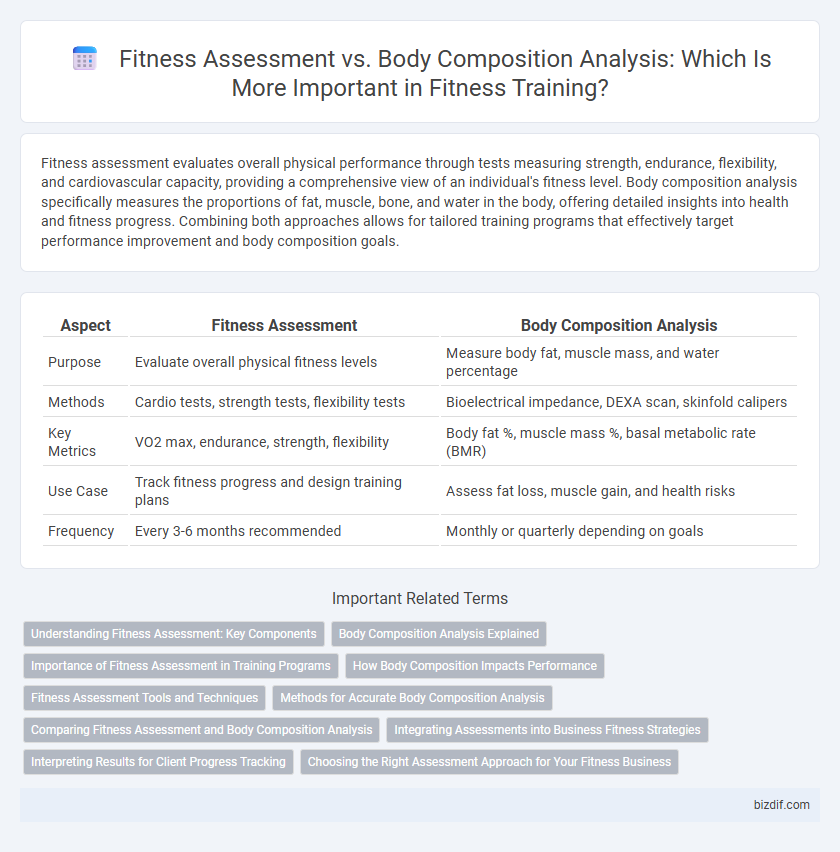Fitness assessment evaluates overall physical performance through tests measuring strength, endurance, flexibility, and cardiovascular capacity, providing a comprehensive view of an individual's fitness level. Body composition analysis specifically measures the proportions of fat, muscle, bone, and water in the body, offering detailed insights into health and fitness progress. Combining both approaches allows for tailored training programs that effectively target performance improvement and body composition goals.
Table of Comparison
| Aspect | Fitness Assessment | Body Composition Analysis |
|---|---|---|
| Purpose | Evaluate overall physical fitness levels | Measure body fat, muscle mass, and water percentage |
| Methods | Cardio tests, strength tests, flexibility tests | Bioelectrical impedance, DEXA scan, skinfold calipers |
| Key Metrics | VO2 max, endurance, strength, flexibility | Body fat %, muscle mass %, basal metabolic rate (BMR) |
| Use Case | Track fitness progress and design training plans | Assess fat loss, muscle gain, and health risks |
| Frequency | Every 3-6 months recommended | Monthly or quarterly depending on goals |
Understanding Fitness Assessment: Key Components
Fitness assessment evaluates cardiovascular endurance, muscular strength, flexibility, and body composition to provide a comprehensive view of overall fitness levels. Key components include measuring heart rate, grip strength, range of motion, and aerobic capacity through tests like VO2 max and sit-and-reach. This multidimensional approach helps tailor personalized training programs and track progress effectively.
Body Composition Analysis Explained
Body Composition Analysis measures the proportions of fat, muscle, bone, and water in the body, offering precise insights into physical health beyond simple weight metrics. This evaluation uses tools like bioelectrical impedance, DEXA scans, or skinfold measurements to identify fat mass and lean body mass, essential for tailored fitness plans. Understanding body composition helps optimize training outcomes, monitor progress, and reduce health risks associated with excess fat or muscle loss.
Importance of Fitness Assessment in Training Programs
Fitness assessment provides a comprehensive evaluation of cardiovascular endurance, muscular strength, flexibility, and overall physical performance, which is crucial for designing personalized training programs. Accurate fitness assessments identify individual strengths and weaknesses, allowing trainers to set realistic goals and track progress effectively. Integrating fitness assessment data enhances motivation and reduces the risk of injury by ensuring exercises are tailored to the trainee's current fitness level.
How Body Composition Impacts Performance
Body composition analysis provides detailed insights into muscle mass, fat percentage, and hydration levels, which directly influence strength, endurance, and recovery capacity during fitness training. Unlike general fitness assessments that measure cardiovascular health or flexibility, body composition metrics allow for tailored workout programs to optimize athletic performance. Understanding lean muscle mass versus fat mass helps trainers and athletes make precise adjustments in nutrition and exercise for enhanced metabolic efficiency and injury prevention.
Fitness Assessment Tools and Techniques
Fitness assessment tools such as VO2 max testing, functional movement screening, and muscle strength evaluations provide comprehensive data on cardiovascular endurance, mobility, and muscular performance. Body composition analysis techniques, including bioelectrical impedance analysis (BIA), dual-energy X-ray absorptiometry (DEXA), and skinfold calipers, quantify fat mass, lean mass, and bone density for precise body makeup evaluation. Combining these tools allows personalized training programs based on fitness levels and physiological metrics.
Methods for Accurate Body Composition Analysis
Accurate body composition analysis relies on methods such as Dual-Energy X-ray Absorptiometry (DEXA), hydrostatic weighing, and bioelectrical impedance analysis (BIA), each offering varying precision and usability. DEXA provides detailed insights into bone density, fat mass, and lean tissue distribution, considered the gold standard in clinical settings. Hydrostatic weighing measures body density under water, while BIA estimates composition through electrical conductivity, favored for ease of use in fitness environments.
Comparing Fitness Assessment and Body Composition Analysis
Fitness assessment evaluates overall physical capabilities such as strength, endurance, flexibility, and cardiovascular health, providing a broad understanding of an individual's functional fitness level. Body composition analysis specifically measures the proportions of fat, muscle, bone, and water in the body, offering detailed insights into how body mass is distributed. Comparing both, fitness assessments identify performance and health capacity, while body composition analysis delivers precise data on physical makeup, making them complementary tools for personalized fitness planning.
Integrating Assessments into Business Fitness Strategies
Integrating fitness assessment and body composition analysis into business fitness strategies enhances personalized training plans and tracks employee health progress with precise metrics like BMI, muscle mass, and fat percentage. Utilizing data-driven insights from these assessments allows companies to design targeted wellness programs that boost productivity and reduce healthcare costs. Combining both methods ensures a comprehensive understanding of physical fitness, enabling more effective goal setting and performance monitoring.
Interpreting Results for Client Progress Tracking
Fitness assessment provides a comprehensive evaluation of strength, endurance, flexibility, and cardiovascular health to gauge overall physical performance. Body composition analysis offers precise measurements of fat mass, muscle mass, and water content essential for tailoring nutrition and exercise programs. Interpreting these combined results enables accurate tracking of client progress, highlighting improvements in muscle development and fat loss while optimizing personalized fitness goals.
Choosing the Right Assessment Approach for Your Fitness Business
Selecting the appropriate fitness assessment approach depends on your business goals and client needs. Fitness assessments evaluate cardiovascular endurance, strength, flexibility, and functional movement to identify performance levels and risks. Body composition analysis provides detailed insights into fat percentage, lean muscle mass, and hydration status, crucial for tailoring personalized nutrition and training programs.
Fitness Assessment vs Body Composition Analysis Infographic

 bizdif.com
bizdif.com